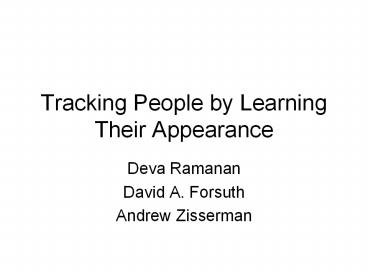Tracking People by Learning Their Appearance - PowerPoint PPT Presentation
1 / 29
Title:
Tracking People by Learning Their Appearance
Description:
Tracking People by Learning Their Appearance Deva Ramanan David A. Forsuth Andrew Zisserman Introduction Problem: to track the articulations of people from video ... – PowerPoint PPT presentation
Number of Views:77
Avg rating:3.0/5.0
Title: Tracking People by Learning Their Appearance
1
Tracking People by Learning Their Appearance
- Deva Ramanan
- David A. Forsuth
- Andrew Zisserman
2
Introduction
- Problem to track the articulations of people
from video sequence. - Need to determine both the number of people in
each frame. - Estimate their configuration.
- Two stage automatic system
- Build a model of appearance of each person in a
video. - Track by detecting those models in each frame.
3
Approach
- Under our model, the focus on tracking becomes
not so much identifying where an object is, but
learning what it looks like. - Bottom-up approach
- Look for candidate body parts in each frame, then
cluster the candidates to find assemblies of
parts that might be people. - Top-down approach
- Look for entire person in a single frame. We
assume people tend to occupy certain key poses,
and so we build models from those poses that are
easy to detect
4
Temporal Pictorial Structures
- First-order Markov model, we replicate the
standard model T times, once for each frame
5
Temporal Pictorial Structures
6
Temporal Pictorial Structures
7
Temporal Pictorial Structures
8
Building Models by Clustering
- An important observation is that we have some a
priori notion of part appearance Ci as having
rectangular edges. - Detect candidate parts in each frame with an
edge-based part detector. - Cluster the resulting image patches to identify
body parts that look similar across time. - Prune clusters that move too fast in some frames.
9
Building Models by Clustering
10
Detecting Parts with Edges
- In the experiments, we used a detector threshold
that was manually set between 10 and 50 (assuming
edge filters are L1-normalized and images are
scaled to 255).
11
Clustering Image Patches
- Mean-shift method.
- We create a feature vector for each candidate
segment, consisting of a 512-dimensional RGB
color histogram(8 bins for each color axis). We
scale the feature vector by empirically-determined
value to yield a unit-variance model in (3).
12
Enforcing a Motion Model
- For each cluster, we want to find a sequence of
candidates that obeys our bounded velocity motion
model defined in (5). - We obtain a sequence of segments, at most one per
frame, where the segments are within a fixed
velocity bound of one another and where all lie
close to the cluster center in appearance. - Prune the sequences that are too small or that
never move.
13
Learning Multiple Appearance Models
- We use the learned appearance to build better
segment detectors. - We search for new candidates using the medoid
image patch of the valid clusters from Fig. 5c as
a template. - Link up those candidates that obey our velocity
constraints into the final torso track in Fig.
5d.
14
Learning Multiple Appearance Models
15
Learning Multiple Appearance Models
16
Approximate Inference
- If the torso localization (and estimated
appearance) is poor, the resulting appearance and
localization estimates for the limbs will suffer. - One remedy might be to continually pass messages
in Fig. 9 in a loopy fashion (e.g., reestimate
the torso appearance given the arm appearance).
17
Building Models with Stylized Detectors
18
Detecting Lateral Walking Poses
19
Discriminative Appearance Models
20
Track by Model Detection
- Multiple scales
- System searches over an image pyramid. It selects
the largest scale at which a person was detected. - Occlusion
21
Track by Model Detection
- Spatial Smoothing( better than direct MAP)
- the smoothed pose tends to be stable since nearby
poses also have high posterior values. - the smoothed pose contains sub-pixel accuracy
since it is a local average. - Temporal Smoothing
- By feeding the pose posterior at each frame into
a formal motion model. - Multiple people
- Multiple instances
22
Results - Building Models by clustering
- Self-starting
- Multiple activities
23
Results - Building Models by clustering
- Lack of background subtraction
24
Results - Building Models by clustering
- Multiple people, recovery from occlusion and
error (see Fig. 18.)
25
(No Transcript)
26
Results - Building Models with a Stylized Detector
- Lateral-walking pose detection
- Appearance model detection
27
(No Transcript)
28
Discussion
- Comparison of model-building algorithms.
- We find the two model-building algorithms
complementary. - If we can observe people for a long time, or if
we expect them to behave predictably, detecting
stylized poses is likely the better approach.
29
(No Transcript)































